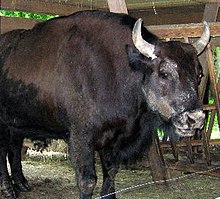Żubroń
This article needs additional citations for verification. (October 2020) |
| Żubroń | |
|---|---|

| |
| A żubroń in Białowieża National Park | |
Domesticated
| |
| Scientific classification | |
| Domain: | Eukaryota |
| Kingdom: | Animalia |
| Phylum: | Chordata |
| Class: | Mammalia |
| Order: | Artiodactyla |
| Family: | Bovidae |
| Subfamily: | Bovinae |
| Tribe: | Bovini |
| Subtribe: | Bovina |
| Hybrid: | Bos taurus × Bison bonasus |
Żubroń (
History
The żubroń was first created by Leopold Walicki in 1847, although the hybrid may also have appeared at an earlier time. After World War I, various scientists considered żubroń a possible replacement for domestic cattle. Żubroń turned out to be more durable and less susceptible to disease. In addition, the animal could be bred on marginal grazing land with no farm infrastructure and with minimal husbandry in huge state agricultural farms (SAFs). From 1958, the work on żubroń herds was continued by the Polish Academy of Sciences in various laboratories, most notably in Białowieża and Młodzikowo. During the first 16 years of experiments, a total of 71 animals were born, including Filon, the first żubroń born to a żubroń mother (August 6, 1960). The animal was intended to become a hardy and cheap alternative to cattle.
The experiment was continued until the late 1980s when the results of the breeding programmes were deemed unsatisfactory. Various factors contributed to this decision, including the severe economic difficulties of the Polish
Description
Żubroń are heavy animals, with males weighing up to 1,200 kg (2,600 lb) and females up to 810 kg (1,790 lb). They are strong, resistant to disease, and tolerant of harsh weather conditions. The first-cross calves have to be born by
See also
References
- ISBN 83-01-14312-6
- ^ (in Polish) Zubry.com Archived 2007-02-12 at the Wayback Machine
- ^ ag (2007-03-05). "Żubr wyrzucony z Bieszczadów za przyjaźń z ludźmi". Gazeta Wyborcza (in Polish). Agora SA. Archived from the original on 2007-03-08. Retrieved 2007-03-06.
